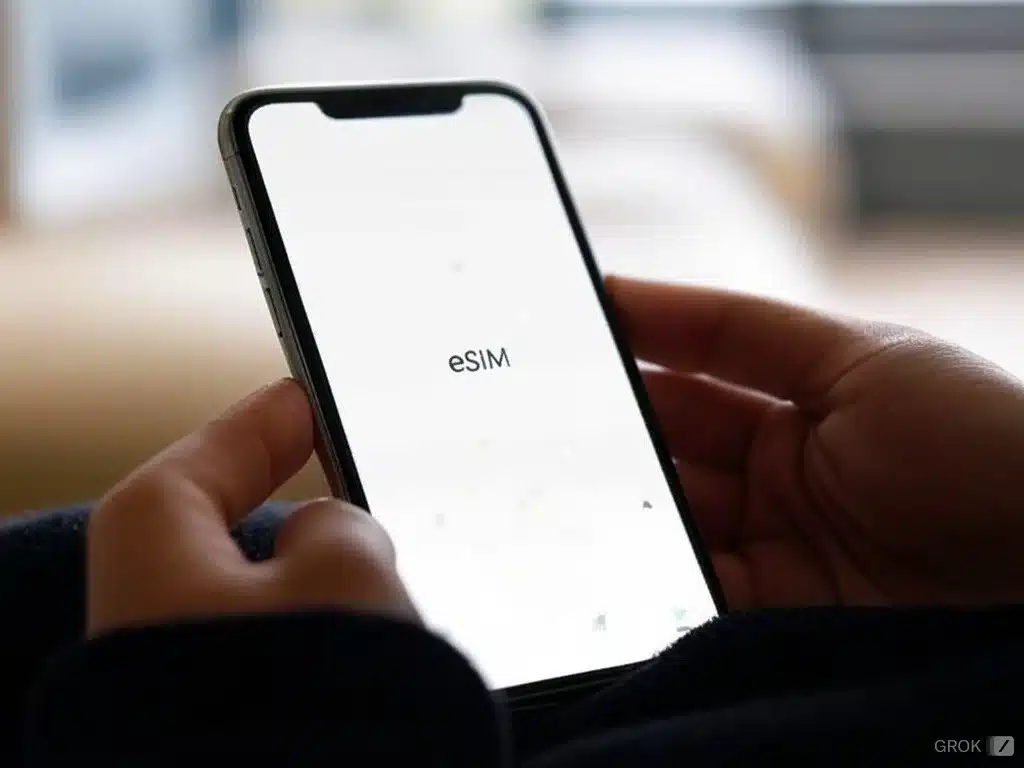Deleting an eSIM on your iPhone or Android device might seem like a quick and simple step, but understanding what happens if I delete an eSIM is crucial before making any changes. Removing your embedded SIM can directly impact your cellular service, mobile data access, and ongoing carrier support. Unlike a traditional physical SIM card, an eSIM is stored digitally inside your phone, and deleting it erases its entire profile, meaning you could lose your connection until it is reinstalled or replaced.
In this guide, we’ll explain in detail what happens if you delete an eSIM, how to remove or reset it safely, and what to expect in terms of network settings, roaming, and connectivity. You’ll also discover best practices for managing eSIM profiles without losing essential services. For a better understanding of how this technology works, check out our dedicated article on what an eSIM is, or learn how to activate an eSIM on your device step by step.

What is an eSIM?
eSIMs explained: basic concepts and functionality
An eSIM is a digital version of a physical SIM card. Instead of inserting a plastic card into your device, an eSIM is embedded in the device’s hardware and can be activated with a QR code or directly from your carrier. It supports multiple accounts, making it ideal for travelers, professionals, or anyone using dual mobile plans.
With eSIMs, users can easily switch between mobile networks, access international plans, or run both personal and work numbers on a single phone. Supported by most modern smartphones including iPhones, Android devices, and Samsung Galaxy, this technology represents the next evolution of mobile connectivity.
For a deeper look, check out our complete guide on what an eSIM is.
What does it mean to delete an eSIM?
Removing an eSIM profile means wiping the virtual SIM data associated with your device configuration. This action disconnects the subscription and erases related data from your phone. It’s a digital deletion, similar to removing an online account.
Once removed, the digital SIM card cannot be reused unless reinstalled with a fresh activation code. Often, this also cancels your data package, unless specific arrangements are made with your network provider.
Why would I need to delete an eSIM?
There are several reasons why users choose to delete an eSIM:
- Switching to a new smartphone
- Troubleshooting network or signal issues
- Changing mobile providers or plans
- Preparing the device for resale or transfer
- Cleaning out expired or inactive accounts
Before removing an eSIM, make sure your account is either deactivated or migrated to another handset to avoid losing service.
Things to consider before deleting an eSIM
Ensure network availability
Before removing your eSIM, check if your carrier allows easy reactivation. If you’re abroad, ensure you have another active SIM card or eSIM to stay connected.
Understand carrier policies and contact your carrier if necessary
Not all providers let you reinstall eSIMs without issuing new QR codes. Some may charge a fee for reactivation. Always contact customer support or review your account dashboard to confirm your options.
For step-by-step help, read our tutorial on how to activate an eSIM.
How to delete an eSIM on an iPhone?
Removing an eSIM from iPhone is straightforward but irreversible:
- Open Settings > Cellular / Mobile Data
- Tap the eSIM profile you want to erase
- Select Remove Cellular Plan
- Confirm
This action will delete the eSIM, clear associated data, and disconnect mobile access tied to that plan. Do this only if you’re switching phones or no longer need that line.
How to delete an eSIM on an Android device?
The process may vary by manufacturer (Google Pixel, Samsung Galaxy, etc.):
- Go to Settings > Network & Internet > Mobile Network
- Select the eSIM line
- Tap Delete / Erase SIM Profile
- Confirm deletion
After this, the eSIM profile and its connection are deleted from your phone.
How to temporarily turn off an eSIM on my device
Temporarily disable an eSIM on an iPhone
- Open Settings > Cellular / Mobile Data
- Toggle off the line tied to your eSIM
This pauses usage without deleting the plan.
Temporarily disable an eSIM on an Android device
- Go to Settings > Mobile Network > eSIM Settings
- Switch the eSIM line to “Off”
This lets you keep the eSIM profile for later without needing to reinstall it.
What happens after deleting an eSIM?
The immediate effects of deleting
When you erase an eSIM, the data plan and carrier connection are disabled instantly. You’ll no longer be able to call, text, or use mobile data tied to that profile, unless a new one is installed.
Loss of network access and mobile services
Your phone will not connect to the mobile network through that eSIM anymore. It also deletes the number and related credentials from the device’s internal storage.
Keeping your plan after eSIM removal
In some cases, removing the eSIM doesn’t automatically cancel your subscription. You might still be charged until you formally cancel it with your provider. Always verify this post-deletion.
Preventing accidental eSIM deletion
Best practices for managing your eSIM
- Label digital SIMs clearly in your device (e.g., “Work”, “Travel”)
- Back up any related data or credentials if your carrier allows
- Keep your activation QR code in a secure location
- Avoid deleting unless changing phones or deactivating the line
For frequent travelers, using an eSIM instead of constantly swapping physical SIM cards makes staying connected simpler. Compare the best international eSIM plans on our eSIM comparison tool before your next trip.
FAQ about what happens If you delete an eSIM

Can I recover a deleted eSIM?
Generally, once deleted, a digital eSIM card cannot be restored unless your carrier allows you to regenerate it or send a new activation code.
Is it possible to recover a deleted eSIM?
Some mobile operators provide eSIM reactivation via their app or customer portal. If not, you’ll need to manually request a new QR code from your provider.
How to restore or recover your deleted eSIM?
- Contact your carrier to request eSIM reactivation
- Use a new QR code or install it via the provider’s official app
- On iPhone, go to Settings > Cellular > Add eSIM
- On Android, go to Settings > Mobile Network and follow the prompts
If you need step-by-step guidance, check out our tutorial on how to activate an eSIM.
Can I recover a deleted eSIM on iPhone?
Yes, but only if your operator supports eSIM reactivation. Apple itself does not store deleted eSIM profiles, so you’ll need a new QR code or activation through your carrier.
Effects of factory reset on eSIMs
Performing a factory reset may erase your eSIM data, depending on your device model and operating system. On iPhones, you’re often given the option to retain eSIM profiles during reset, while many Android phones remove them by default. Always back up important information and check your reset options to avoid losing your digital SIM.
If I reset my device, will it delete my eSIM?
Most Android factory resets will remove your eSIM unless backed up. On iPhone, you can choose whether to keep or erase eSIM profiles during the reset process.
Does deleting an eSIM remove the carrier lock?
No. Carrier locks are tied to the device hardware, not the SIM profile. Deleting your eSIM will not unlock your smartphone.
How to fully delete an eSIM from an iPhone?
Go to Settings > Cellular, tap on the plan, and select Remove eSIM. The eSIM profile will then be cleared from the device.
How to deactivate or reactivate an eSIM on iPhone?
- To deactivate, toggle off the line in your cellular settings
- To reactivate, use the original QR code or request a new one from your provider
Removing an eSIM clears your cellular subscription and profile, which may disrupt your service and require support to recover. Unlike a physical SIM card, reinstallation usually involves a fresh activation process. If you’re unsure, it’s often safer to disable the eSIM temporarily rather than deleting it completely.
Want to explore the best eSIM plans for international travel or learn how to switch from a physical SIM to an eSIM? Visit our eSIM comparison tool and our detailed guide on switching to eSIM to get started with confidence.e.
Other articles
-
-
30 September 2025
-
5 September 2025



